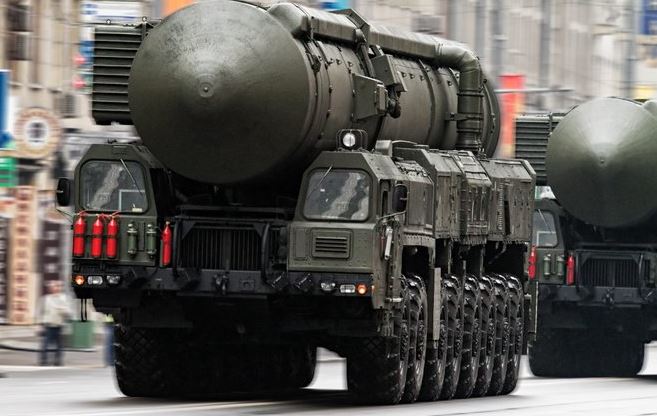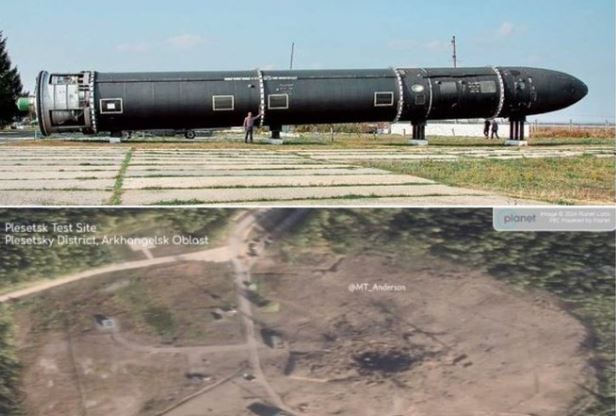Satellite images have revealed a significant crater at a Russian missile test center after a failed test of the nuclear-capable RS-28 Sarmat, commonly known in the West as “Satan-2.” The missile reportedly exploded at the Plesetsk cosmodrome in Arkhangelsk during testing, marking the fourth consecutive failure of the weapon, a major setback for Russia’s strategic arsenal and President Vladimir Putin.

The RS-28 Sarmat is seen by the Kremlin as a cornerstone of its military power, but repeated test failures have raised serious concerns about its reliability. The recent incident has once again drawn attention to the missile’s ongoing development issues.
Also Read: Ukraine Peace Efforts Hit Roadblock as Russia Rejects Summit Follow Up
Social media analyst MeNMyR, sharing satellite images from Planet Labs, confirmed the disastrous outcome: “As evident from the imagery, the RS-28 Sarmat test was a complete failure. The missile detonated in the silo, creating a massive crater and severely damaging the test site.”
The Sarmat missile, which uses liquid fuel, may have encountered problems during the fueling process, rather than during the actual launch. MeNMyR speculated that this could explain the absence of U.S. Cobra Ball reconnaissance activity on the day of the explosion. The analyst noted that the only successful test of the Sarmat occurred on April 20, 2022.
The RS-28 Sarmat, standing 35 meters tall and with a range of up to 11,000 miles, is believed to cost around £38 million per unit. However, its repeated failures have cast doubt on its effectiveness as a reliable deterrent. Oleksandr Kovalenko, a Ukrainian military expert, described the missile as “unreliable and dangerous,” stating that Russian forces have struggled to successfully execute test launches.
This latest failure occurred just days after Russia celebrated the successful test of its Angara 1.2 launch vehicle, which carried a military spacecraft into orbit from the same facility. While the Angara test was a success, the setback with the RS-28 Sarmat could potentially delay further testing.
Meanwhile, Ukraine continues to ramp up its efforts in the ongoing conflict, recently launching a major drone attack on Russian arms depots. President Volodymyr Zelensky is calling for swift military aid from the United States as he prepares for a high-profile visit to the White House with a strategic “victory plan.”
The missile test failure adds another layer of complexity to Russia’s military challenges, further impacting its defense strategy amid mounting tensions.
Key Points
- Massive Crater Found: Satellite images show a massive crater at Russia’s Plesetsk cosmodrome after the explosion of the RS-28 Sarmat missile.
- Fourth Consecutive Failure: The failed test marks the fourth consecutive failure of the nuclear-capable RS-28 Sarmat missile, raising doubts about its reliability.
- Sarmat’s Strategic Role: The RS-28 Sarmat, known as “Satan-2” in the West, is a key part of Russia’s strategic nuclear arsenal but continues to face development issues.
- Analysis of Failure: Social media analyst MeNMyR confirmed that the missile exploded in its silo, possibly due to a fueling issue, severely damaging the test site.
- Cost and Capabilities: The RS-28 Sarmat is 35 meters tall, has a range of 11,000 miles, and costs approximately £38 million per unit.
- Ukrainian Expert’s Comment: Ukrainian military expert Oleksandr Kovalenko described the missile as “unreliable and dangerous” due to Russia’s difficulty in conducting successful tests.
- Angara Launch Success: Days before the Sarmat failure, Russia successfully tested its Angara 1.2 launch vehicle from the same facility, carrying a military spacecraft.
- Ukraine’s Military Action: Ukraine launched a significant drone attack, destroying Russian arms depots, while President Zelensky seeks further U.S. military aid ahead of his visit to the White House.



